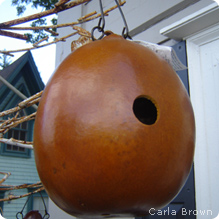
Bird houses made out of dried gourds attract only one kind of bird – purple martins. And they are wonderful neighbors because they eat huge quantities of mosquitoes.
What You Need
- A grown gourd or gourd seeds
- A very tall pole
- A wide space ideally a large yard near a meadow
- Expansion bit or keyhole saw
What You Do
- Identify whether purple martins live in your area.
They can be difficult to spot except at gourd colonies. If you can find anyone near your home who has gourds, that is a good sign that you can attract purple martins also. This bird lives mostly along the east and west coasts of North America, breeding in Canada. The male bird is navy blue and black in color. The female bird is pale gray. - Identify where you will put the gourd colony.
You’ll need a lot of space to make your gourd colony. You need to string up at least 10 of them in any area because they like to live in groups. You’ll also need a pole that is very high up. - Purchase a gourd or gourd seeds.
Gourds used for purple martin houses are from the lagenaria group, which includes a type of gourd called Birdhouse. According to the Ohio State University Extension, “these plants produce white blossoms that bloom at night. Lagenaria gourds are green on the vine, turning brown or tan, with thick, hard shells when dry. “ - Grow your gourds.
The gourds can be challenging to grow. They need a long growing season. The best areas to grow these gourds are in the southern United States. However, if you live in the north, you can successfully grow gourds if you know how to head-start plants inside during the winter and spring. You need to start them four weeks before the last frost, and then put them in the garden in late spring in well-prepared fertile soil. Select a sunny, well-drained site because the seeds will rot in cold, wet soil. Make sure your transplants are at least two feet apart. Once the plants start to grow, keep them fertilized with a regular compost top-dressing. - Harvest your gourds.
Gourds are ready for harvest when the stems dry and turn brown. It is best to harvest gourds before frost. For a purple martin house, pick a gourd that is at least 10 inches wide. - Dry your gourds.
Clean the gourds with soap and water or warm vinegar water. Apply rubbing alcohol to the surface. Put the gourds in a dry. Check them often and take out any that start to rot. It can take a few months for the gourds to dry on the inside. It’s helpful if the gourds can be stored in a warm place to speed up the process and avoid rot. Your gourd is dried when it becomes light and seeds rattle inside. - Cut an entry hole in the gourd, and small holes in the top and bottom.
Cut a hole with an expansion bit or a key hole saw. Make sure the hole is towards the top to keep the babies from falling out. The hole needs to be about 2 ½ inches wide. Holes in the bottom allow drainage and keep the gourd dry. Two small holes in the top allow you to string in a wire to hang the gourd. Don’t attach a perch below the hole because this gives predators something to hold. - Varnish the gourd.
Ideally, don’t paint the gourd, but a layer of varnish or shellac will increase its strength. - Hang the gourd houses at least two stories up.
Make a cross bar on a pole and hang multiple gourds together from a strong cable wire. Ensure the gourds are hung away from trees or wires so the birds have a clear route to their homes.


